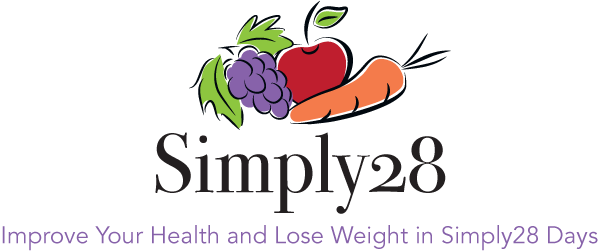There’s a section in my book that says:
“The foundation of Simply28 is choosing high-quality proteins and low-glycemic vegetables complemented with healthy fat to satiate the appetite. Add in moderate amounts of starchy vegetables and seasonal fruit to provide nutrients, dietary fiber, and variety.”
I come back to these words often when people ask, “Is it truly possible to transform my health and improve other areas of my life as a result?” The answer to the question is a resounding YES! I am confident that with the Simply28 nutritional foundations, you can improve your health, have more energy, and enjoy a healthy and happy life.
Following these foundational guidelines optimizes health for many people, but what about those of us who have to pay even closer attention to our blood sugar levels? How does the foundations and particularly fiber impact blood sugar levels? In today’s blog post, I want to get into the role of fiber in a healthy diet and how to use it effectively when it comes to lowering blood sugar levels. You’ll learn about 4 ways that will help you rewire your metabolism, lower blood sugar levels, and help you improve your health so that you can feel your best.
First Let’s Understand Fiber
Dietary fiber is a type of carbohydrate that the human body cannot digest. Unlike sugars and starches, which are broken down into glucose during digestion, fiber remains largely intact as it travels through the digestive system. There are two main types of dietary fiber: soluble and insoluble.
Soluble Fiber: Dissolves in water and forms a gel-like substance. Found in foods such as oats, beans, lentils, and some fruits, soluble fiber has been associated with various health benefits, including blood sugar regulation.
Insoluble Fiber: Does not dissolve in water and adds bulk to stool, aiding in regular bowel movements, and “scrubbing” our intestinal wall as food moves through. Whole grains, nuts, and vegetables are common sources of insoluble fiber.
When you consume a meal containing carbohydrates, the digestive process usually leads to a rapid rise in blood sugar levels. However, the presence of soluble fiber in the meal can slow down the absorption of glucose, leading to a more gradual and controlled increase in blood sugar.
The glycemic index is a measure of how quickly a carbohydrate-containing food raises blood sugar levels. Foods with a high GI rating cause a rapid spike in blood sugar. Foods with a low GI rating produce a slower, more gradual increase. Including fiber-rich foods in your diet can lower the overall glycemic index of a meal, thus moderating the impact on blood sugar levels.
In the quest for better health and managing chronic conditions like diabetes, nutrition plays a crucial role. Among the various dietary components, fiber has been praised for its potential benefits in promoting overall well-being and for its ability to help lower blood sugar levels. However, increasing fiber alone is typically not enough to reduce blood sugar levels for those who are experiencing high fasting glucose levels, high A1C levels, metabolic syndrome, or even endocrine disruption leading to hormonal problems.
The Four Pillars
The following Four Pillars are essential for optimizing health and specifically for lowering blood sugar levels. Fiber, protein, fat, and exercise can all play important roles in helping to reduce blood sugar levels, particularly for individuals with insulin resistance, diabetes, or those at risk of developing diabetes. Here’s how each of these pillars contribute to blood sugar management:
Fiber: Dietary fiber is found in plant-based whole foods like fruits, vegetables, whole grains, legumes, and nuts. Soluble fiber, in particular, helps slow down the digestion and absorption of carbohydrates, which leads to a slower and more gradual increase in blood sugar levels after eating. It can also promote a feeling of fullness and prevent overeating, helping to manage body weight.
Protein: Including protein-rich foods like meats, poultry, fish, eggs and dairy (if well tolerated) in your diet can help stabilize blood sugar levels. Protein slows down the digestion process, leading to a more gradual release of glucose into the bloodstream after meals. Protein consumption can also help maintain muscle mass, which is essential for glucose uptake and metabolism.
Healthy Fats: Consuming healthy fats, such as those found in avocados, nuts, seeds, olive oil, aged cheese, and butter from grass-fed cows can help improve insulin sensitivity and regulate blood sugar levels. Including fats in meals can slow down digestion and absorption of carbohydrates, leading to a more controlled rise in blood sugar. Omega-3 fatty acids, found in fatty fish like salmon, sardines, mackerel, and cod liver oil have been shown to have anti-inflammatory effects that may improve insulin sensitivity. Anti-inflammatory omega-3 fats are also higher in meat and dairy that comes from grass-fed and finished cows whereas products from grain-fed cows are higher in inflammatory fats.
Exercise: Physical activity increases the uptake of glucose by muscle cells, which can lower blood sugar levels. Exercise improves insulin sensitivity, making cells more responsive to insulin and helping to regulate blood sugar more effectively. Regular exercise can also aid in weight management, which is crucial for blood sugar control, as excess weight can lead to insulin resistance. Even something as simple as going for a leisurely walk after a meal is helpful in moving glucose out of the blood steam.
While eating high carbohydrate foods that are high in fiber such as grains, sweet potatoes, and fruit can be helpful in reducing absorption of carbohydrates, as opposed to processed foods made from white flour and sugar, they still have an impact on blood sugar. Combining whole foods that contain fiber with protein and fat, leads to more stable blood sugar levels, enhanced insulin sensitivity, and improved overall health. Below are some healthy alternatives that are helpful when it comes to reducing blood sugar levels and will keep you feeling full and satiated for longer periods of time.
| Instead of This | Eat this |
| Apple | Half an apple with almonds or slice of cheese |
| 1 cup of Oatmeal | ½ cup oatmeal with cottage cheese or egg |
| Muffin made with white flour | Paleo style muffin made with almond flour |
| Flavored yogurt and granola sweetened with sugar, honey, or high fructose corn syrup. | Plain whole milk yogurt sweetened with fresh whole berries and/or stevia and nuts. |
| Sweetened sports drink or soda | Mineral water with a squeeze of citrus |
| Bowl of cereal | Scrambled eggs with avocado and sliced tomato |
| Pasta topped with Marinara Sauce | Zucchini noodles topped with Bolognese or meat sauce. |
>>>For more low carb/high fiber recipes and snack ideas, order your copy of The Simply28 Real Food Cookbook today.<<<





